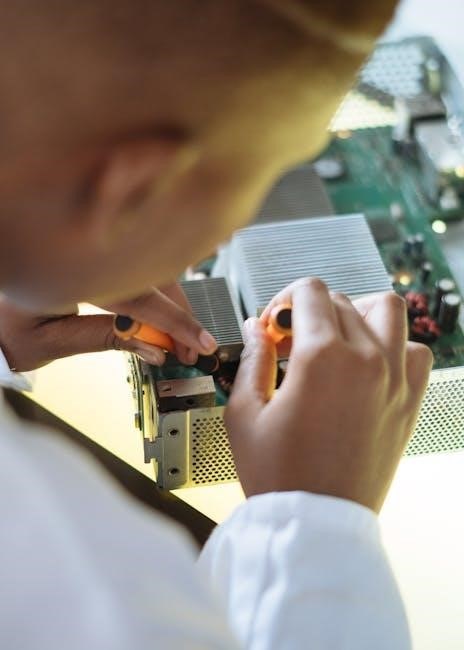
The Irritrol Irrigation Controller Manual serves as a comprehensive guide for installing, programming, and troubleshooting Irritrol controllers. It covers models like the RD600-EXT-R and highlights features such as manual operation, wireless connectivity, and rain sensor compatibility. Essential for efficient irrigation management, this manual ensures optimal system performance and water conservation.
1.1 Overview of Irritrol Controllers
Irritrol controllers are highly efficient irrigation management systems designed for residential and commercial use. Available in 6-, 9-, and 12-station models, they offer flexibility for varying lawn and garden sizes. These controllers support manual operation, automatic scheduling, and smart features like wireless connectivity and rain sensor integration. With user-friendly interfaces and advanced programming options, Irritrol controllers provide precise water control, ensuring optimal hydration while conserving resources. Their durability and compatibility with additional devices make them a popular choice for modern irrigation needs.
1.2 Importance of the Manual for Proper Usage
The manual is crucial for understanding and utilizing Irritrol controllers effectively. It provides detailed instructions for installation, programming, and troubleshooting, ensuring users maximize their system’s potential. Without the manual, users may struggle with setup or miss advanced features like smart apps and rain sensors. Proper adherence to guidelines helps prevent errors, enhances water efficiency, and extends the controller’s lifespan. Referencing the manual guarantees safe and optimal operation, making it an indispensable resource for both new and experienced users.

Key Features of Irritrol Irrigation Controllers
Explore the innovative features of Irritrol controllers, including multiple station models, manual operation, wireless connectivity, and smart app integration. These tools enhance efficiency and customization for optimal irrigation management.
2.1 Station Models (6-, 9-, and 12-Station)
Irritrol controllers are available in 6-, 9-, and 12-station models, catering to various lawn sizes and irrigation needs. The 6-station model is ideal for smaller yards, while the 12-station version offers greater flexibility for larger properties. These models support multiple zones, allowing precise control over watering schedules and customization. Outdoor models are durable and weather-resistant, while indoor variants provide sleek, space-saving designs. All models ensure efficient water distribution and are compatible with advanced features like rain sensors and smart apps for enhanced functionality and convenience.
2.2 Manual Operation Mode
The Manual Operation Mode allows users to override automatic schedules, enabling immediate watering of specific stations. This feature is ideal for unexpected watering needs or system testing. Accessible via the controller’s interface, manual mode operates independently of programmed schedules, ensuring flexibility. The Electronic Circuit Breaker further enhances safety by preventing overloads. This mode is particularly useful for quick adjustments, offering precise control over irrigation without altering existing programming, making it a versatile option for tailored watering requirements.
2.3 Wireless Connectivity and Smart Apps
Irritrol controllers offer advanced wireless connectivity, enabling seamless integration with smart apps. Users can manage irrigation schedules, monitor system status, and receive notifications via their smartphones or tablets. The Smart Dial Technology and compatibility with wireless rain sensors enhance efficiency. These features allow remote adjustments, ensuring optimal watering even when away from home. The mobile app provides detailed insights and customizable settings, making it easier to conserve water while maintaining healthy landscapes. This technology elevates irrigation management to a new level of convenience and efficiency.

Installation and Setup
Installing and setting up an Irritrol controller involves mounting, wiring, and configuring the device; Ensure the controller is protected from environmental factors and properly grounded for safe operation.
3.1 Mounting the Controller
Mounting the Irritrol controller securely is crucial for reliable operation. Choose a location protected from direct sunlight and water exposure, especially for outdoor models. Ensure the controller is installed near a water source and a grounded AC power outlet. For indoor models, select a dry, accessible area. Use the provided mounting hardware to secure the controller firmly to the wall. Avoid areas prone to moisture or extreme temperatures. Proper mounting ensures longevity and prevents damage from environmental factors, keeping your irrigation system functioning optimally.
3.2 Wiring the Controller
Wiring the Irritrol controller requires careful attention to ensure proper system function. Use low-voltage wiring to connect the controller to solenoids, sensors, and other components. Begin by connecting the power wires to a grounded AC circuit. Next, wire each station terminal to the corresponding solenoid valve, ensuring correct polarity. Connect any sensors, such as rain sensors, to the designated terminals. Avoid wiring near high-voltage lines or sources of interference. Turn off power before starting and consult the manual for specific wiring diagrams to ensure a safe and accurate installation.
3.3 Initial Setup and Configuration
After mounting and wiring the controller, proceed with initial setup. Set the time, date, and language. Configure each station by assigning names or zones. Define watering times, durations, and frequencies for each zone. Enable features like rain delay or water-saving modes if available. Test each station to ensure proper operation. Refer to the manual for specific button sequences and menu navigation. Proper configuration ensures efficient irrigation schedules and optimal water usage tailored to your landscape needs.

Programming the Irritrol Controller
Programming the Irritrol controller involves setting watering schedules, start times, and durations for each station. Use manual or smart app modes for efficient irrigation management and water conservation.
4.1 Basic Programming Steps
Programming your Irritrol controller begins with powering on the device and setting the date and time. Next, select the station you wish to program and choose the operation mode—manual or automatic. Set the start time and water duration for each station, ensuring optimal irrigation schedules. Finally, save your settings and test the system to confirm proper operation. This straightforward process ensures efficient watering management tailored to your landscape needs.
4.2 Setting Up Watering Schedules
To set up a watering schedule, select the desired station and choose the watering frequency (e.g., daily, every 2 days). Set the start time and adjust the water duration for each station. Use the Smart Dial feature for precise control. Save your settings to activate the schedule. This process ensures consistent irrigation tailored to your lawn’s needs, promoting healthy plant growth while conserving water. Always test the schedule to confirm proper operation.
4.3 Manual Station Operation
Manual station operation allows immediate watering without waiting for scheduled cycles. Press the ‘Manual’ button, then use the arrow keys to select the desired station. Set the desired watering duration and press ‘Start.’ The controller will activate the selected station. This feature is ideal for quick watering adjustments or testing individual stations. Ensure the controller is in manual mode before initiating to avoid conflicts with programmed schedules. Always return to automatic mode after manual operation to maintain your set watering routines. This ensures seamless functionality and optimal irrigation control.

Troubleshooting Common Issues
Identify issues by checking error codes, wiring connections, and power supply. Ensure proper station activation and review programming settings. Reset the controller if necessary to resolve operational faults.
5.1 Identifying and Solving Common Problems
Common issues with Irritrol controllers include error codes, faulty wiring, or station malfunctions. Check connections, ensure proper power supply, and verify programming settings. Reset the controller if necessary. Consult the manual for error code meanings and solutions. Addressing issues promptly prevents system downtime and ensures efficient irrigation. Regular maintenance and updates can help avoid recurring problems. Always refer to the troubleshooting section for detailed guidance on resolving specific faults effectively.
5.2 Error Codes and Their Meanings
Irritrol controllers display error codes like E1, E2, or E3, indicating issues such as low battery, faulty sensors, or communication problems. E1 often relates to the rain sensor, while E2 may signal a wiring issue; E3 could indicate a malfunction in the electronic circuit breaker. Refer to the manual for specific code meanings and step-by-step solutions. Addressing these errors promptly ensures smooth system operation and prevents further complications. Always consult the troubleshooting guide for detailed repair instructions.

Maintenance and Care
Regularly clean the controller, update firmware, and winterize the system to ensure optimal performance. Protect the unit from environmental factors like direct sunlight and moisture exposure.

6.1 Cleaning the Controller
Cleaning the Irritrol controller is essential for maintaining its functionality. Use a soft, dry cloth to wipe away dirt and debris from the exterior. Avoid harsh chemicals or liquids, as they may damage the electronics. Gently remove any dust or moisture that could interfere with the system’s operation. Regular cleaning prevents corrosion and ensures reliable performance. For tougher stains, a slightly damp cloth can be used, but ensure the unit is dry before powering it on. This simple maintenance step extends the lifespan of your irrigation controller.
6.2 Updating Firmware
Updating the firmware of your Irritrol irrigation controller ensures optimal performance and access to the latest features. Check the manufacturer’s website for updates specific to your model. Download the firmware file and follow the instructions provided in the manual. Use a USB connection or Wi-Fi, depending on your controller’s capabilities. After updating, restart the system to apply changes. Regular firmware updates improve functionality, add new features, and fix potential bugs. Always refer to the manual for detailed steps to avoid errors during the update process.
6.3 Winterizing the System
Winterizing your Irritrol irrigation system is essential to prevent damage from freezing temperatures. Drain all water from the pipes and sprinklers to avoid ice formation. Use the manual operation mode to ensure all stations are cleared of water. Protect the controller by disconnecting it from the power source and storing it in a dry, cool place. Insulate exposed pipes if necessary. Consult the manual for specific winterization steps tailored to your controller model. Proper winter care ensures your system remains functional and ready for the next irrigation season.

Advanced Features
Irritrol controllers offer advanced features like Smart Dial technology, RainSensor compatibility, and water-saving settings, enhancing efficiency and convenience. These innovations optimize irrigation performance and resource usage, ensuring precise control over watering schedules and environmental adaptability. Users can explore these features to maximize their system’s potential and reduce water waste, tailored to specific irrigation needs and preferences. Review the manual for detailed guidance on leveraging these advanced capabilities effectively.
7.1 Smart Dial Technology
Smart Dial Technology simplifies irrigation control with an intuitive interface. It allows users to manually operate stations and adjust watering schedules effortlessly. This feature enhances precision, enabling quick changes to irrigation plans without complex programming. Compatible with various Irritrol models, Smart Dial ensures seamless operation and efficient water management. By streamlining manual overrides and adjustments, it provides flexibility for specific watering needs, making it a valuable tool for both residential and commercial irrigation systems. Refer to the manual for detailed instructions on utilizing Smart Dial effectively.
7.2 RainSensor Compatibility
Irritrol controllers are compatible with wireless RainSensors, which automatically adjust watering schedules based on rainfall. This feature prevents overwatering and conserves water. The sensor integrates seamlessly with the controller, ensuring efficient irrigation. By monitoring rainfall, it pauses or skips irrigation cycles when unnecessary. This compatibility enhances system efficiency and aligns with water-saving goals. Users can install the RainSensor alongside their controller for optimal performance. Refer to the manual for detailed installation and configuration instructions to maximize the benefits of this innovative feature.
7.3 Water-Saving Settings
Irritrol controllers offer advanced water-saving settings that optimize irrigation efficiency. Features like rain delay, soil moisture sensors, and weather-based adjustments help reduce water usage. Users can set specific watering schedules and customize durations to match plant needs. Additionally, smart apps enable remote monitoring and adjustments, ensuring water is used wisely. These settings not only conserve water but also maintain healthy plant growth. The manual provides detailed guidance on activating and configuring these features for maximum efficiency and environmental benefit.

Models and Variants
Irritrol offers a range of controllers tailored to different needs. Models include indoor and outdoor variants, Junior DC, and MCplus Series. Each ensures reliability and efficiency.
8.1 Indoor vs. Outdoor Models
Irritrol controllers are available in both indoor and outdoor models, each designed for specific environments. Indoor models are ideal for protected areas, ensuring safe operation away from weather conditions. Outdoor models, like the RD600-EXT-R, are built to withstand harsh weather, offering durable performance. Both options provide reliable irrigation control, but their placements require consideration of exposure to direct sunlight and moisture. Choosing the right model depends on installation location and environmental factors to ensure optimal functionality and longevity of the system.
8.2 Junior DC Controller
The Junior DC Controller is a cost-effective, straightforward irrigation control solution designed for smaller landscapes. It operates on direct current (DC) power, making it energy-efficient and suitable for basic irrigation needs. With its simple interface, it allows manual operation and easy programming. Ideal for residential use, the Junior DC Controller offers reliable performance without advanced features, making it a practical choice for users seeking a no-frills irrigation control system. It is part of Irritrol’s range of controllers designed to meet diverse user requirements.
8.3 MCplus Series Controllers
The MCplus Series Controllers are advanced irrigation control systems offering enhanced features like wireless connectivity and smart app compatibility. They support up to 12 stations, making them suitable for larger landscapes. With user-friendly interfaces and efficient programming options, these controllers ensure precise watering schedules. They also integrate with rain sensors, promoting water conservation. Designed for both residential and light commercial use, the MCplus Series combines durability with cutting-edge technology, providing a reliable and efficient irrigation solution for diverse needs. They are a top choice for modern irrigation management.

Safety Precautions
Ensure electrical safety by using grounded circuits and avoid exposing controllers to direct sprinkler spray or harsh weather conditions. Follow installation guidelines to prevent damage and ensure proper operation.
9.1 Electrical Safety
Always connect your Irritrol controller to a grounded AC circuit to prevent electrical hazards. Avoid exposing the unit to water or moisture, as this can cause malfunctions or shocks. Never attempt repairs without disconnecting the power supply. Use a licensed electrician for any hardwiring to ensure compliance with safety standards. Proper grounding and electrical connections are crucial for safe and reliable operation of the irrigation system.
9.2 Protection from Environmental Factors
Protect your Irritrol controller from direct sunlight, rain, and extreme temperatures to ensure longevity. Outdoor models should not be exposed to sprinkler spray or moisture. Mount the controller in a shaded, dry area to prevent overheating. Use weather-resistant enclosures for outdoor installations. Avoid placing the unit near chemicals or corrosive substances. Regularly inspect and clean the controller to remove dirt or debris. Proper environmental protection ensures reliable performance and extends the lifespan of your irrigation system.
The Irritrol Irrigation Controller Manual provides a detailed guide to optimizing your irrigation system. By following the manual, users can ensure efficient watering, water conservation, and system longevity. It covers installation, programming, and troubleshooting, making it an essential resource for both new and experienced users. The manual emphasizes proper usage and care, ensuring your Irritrol controller operates at its best. With clear instructions and advanced features, it helps you achieve a perfectly irrigated landscape while saving water and time.